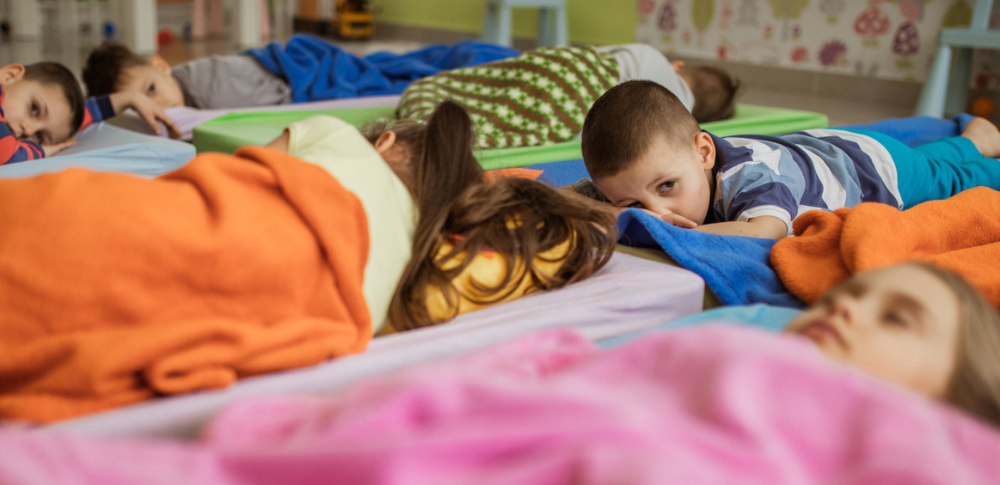Successful Sleep Strategies in Child Care
Published on Wednesday, 11 January 2023
Last updated on Tuesday, 24 January 2023

Successful Sleep Strategies in Child Care
Front sleepers, side sleepers, back, and upside-down sleepers - you name it, everyone has their own unique ways of sleeping. Especially children and babies. Some people choose to sleep their children in cribs, while others in cots, swings, or hammocks - some choose to co-sleep with their kids and that's OK too! A lot of the time, culture and customs come into play when it comes to household sleeping habits - none are right or wrong but put them all in one room and try to get them to nap at the same time without a proper plan, you have chaos!
Child care educators have a task ahead of them and a massive role to play when it comes to providing a sleep environment that's not only comfortable and safe but functional.
Safe Sleep environment
As noted above, sleep environments differ from home to home. Some parents like to create a noisy environment while others keep things quiet and calm. Some children also share rooms with siblings, making for a chatty start to their slumber. Taking the time to discuss the home sleep environment with parents or carers of the children in your centre, will improve your chances of getting them off to sleep.
Babies who are nursed or pat to sleep might find it challenging to be left to self-settle in a lonely crib and you might find they wake frightened. Babies used to being nursed could benefit from being swaddled up nice and tight - snug as a bug in a rug!
Some toddlers are used to two daytime naps and could have trouble adjusting to a new schedule but if they can't sleep, consider a quiet space where restless toddlers can retreat to read or rest.
Comfort is key
Educators can help children feel more at home by thinking of sleep routines almost as individual learning plans (ILPs). All children's sleep needs are unique and you should aim to work with parents to understand each child when they begin at the centre. Aligning the home routines as closely to the care routines as possible gets you closer to a successful sleeping pattern.
Creating comfy spaces where children are made to feel at home will also make things easier. If a baby or child is used to a noisy sleep environment, they might sleep more comfortably closer to the opening of another room where noises spill through.
When you're chatting with families, make a point to mention that items from home are encouraged. For example, if the child has a favourite toy or blanket, it's welcome to be in the centre and will be provided at sleep time. Always be sure to follow the Safe Sleep Practices of Red Nose Australia when adding anything to the sleeping spaces.

Keep clued in
Using your detective work when it comes to the children in your care gets easier over time. The more you observe, the more you learn! Some children will show tired signs at a similar time each day. Others won't fall asleep easily at all and can be a little trickier to track. Stay on top of it and make sure you're keeping a watch on when Suzie starts to yawn and get restless.
The keys to success can be counted on one hand!
- Individual sleep plans
- Routine, routine, routine
- Smooth operator
- Environmental energy
- Get moody
Individual sleep plans
Every child's sleep habits and routines are different - as they are with adults. Some babies are calmer and adjust to new settings while others need a set structure. Babies and young toddlers sleep at various times of day, so it may not work to have a strict structure for a group. Older children are commonly better at following a set schedule. Taking all of this into account will certainly help!
Routine, routine, routine
Positive sleep outcomes will rely heavily on a good routine. A good routine allows time for active play, quiet play, and incorporating sufficient exercise.
Smooth operator
For older children, rest time often follows mealtime. Transitioning from lunching to resting can be tough. If you have a few slow eaters and you're trying to get everyone to rest at the same time, try to have your faster eaters first transition to a quiet corner. This will minimise noise and movement, giving you a better chance to smoothly transition to rest.
Environmental energy
The sleeping environment is all about energy - a low, calm energy. Take a classroom approach to the layout and ensure that the besties in the class aren't napping together - they're going to chat! Keeping the kids in the same place each day will also lower the chance of chaos in the smooth transition to sleep.
Get moody
Lower the lights and the blinds and create some mood lighting. Kids relax easily if their rest area and mood mimic their home space. Keep the mood light, the space quiet and dark while setting the mood with a little soft music.
Get in touch!
If you have some expert advice on how to get children to sleep or any other subject, get in touch with our team! We'd love to hear from you - marketing@careforkids.com.au
Related Articles

Settling your child into a good sleep routine at care
Maintaining a healthy sleep routine when your child starts care.

11 safe sleeping practices
Early childhood educators play an important role in helping children and their parents develop safe practices to support quality sleep.

Mandatory sleep and rest policies
Mandatory sleep and rest policies.
